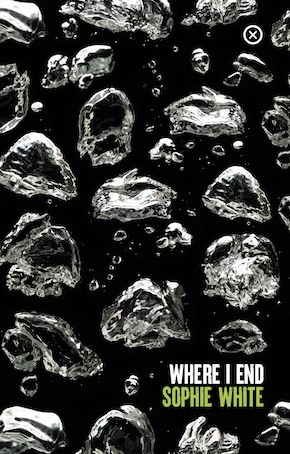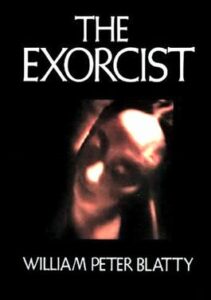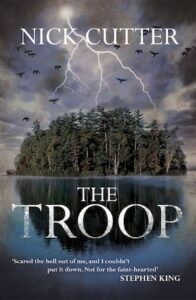Embracing the dread
by Sophie White
“Disturbing, brutal, chilling, this book truly is a horror. It’s also Sophie White’s best book yet.” Doireann Ní Ghríofa
Horror novels have an incredible ability to take us out of our lives and excite our imaginations. Reading a novel is great exercise for the mind as we build images in our heads of the worlds on the page, and this becomes even more pertinent when we read horror and our brains start to spawn the vivid locations and horrifying monsters. As a teenager, horror novels were my gateway drug to reading. I was devoted to the Goosebumps and Point Horror series before I graduated to some of the classics of the genre like Carrie and The Shining. I vividly remember reading The Exorcist under the table in French class and becoming intensely anxious that if someone was able to read my mind at that moment they’d think I was utterly sick and twisted. It was quite a specific paranoia!
Horror allows us to explore our most unspeakable fears, and by confronting them, vanquish them (sort of, almost!). Perhaps because I am bi-polar, I love horror even more than the average fan. In horror stories, the threat is always ‘out there’ as opposed to the threat of mental illness, which is the real-life equivalent of ‘the call is coming from inside the house’. With horror, most of the time there is a tangible cause of the terror, whereas with mental illness, the dread is so often formless and therefore more horrifying than any ghost or monsters can ever be.
Some of my favourite horror novels include:
Carrie by Stephen King
(Doubleday, April 1974)
I loved books when I was a kid but it wasn’t until the first year of secondary school that I got a hold of this book and felt my world opening wider. Not only was Carrie utterly compelling and frightening, it’s also a really accessible read and the perfect gateway drug to King’s formidable back catalogue. I was obsessed with the book’s structure – it’s a sort of meta-narrative that uses newspaper clippings, letters and excerpts from other books to tell Carrie’s story of being a teenage girl coming into her (supernatural) powers and exacting revenge on her sadistic classmates and mother. I think a good indicator of how much you love a book is if you can remember where you were when you read it. The books I’m reading always colour my days. When I think of reading Carrie not only is the book vivid but so is my thirteen-year-old self reading it and I remember what it felt like skulking in the stacks of the new ‘grown-up’ library at my new ‘grown-up’ school and feeling as lost as Carrie, though thankfully not as homicidal!
The Pallbearers Club is meta-fiction at its finest and funniest… part nostalgic coming-of-age story, part psychological thriller.”
The Pallbearers Club by Paul Tremblay
(Titan Books, July 2022)
The Pallbearers Club is Tremblay’s tenth book and perhaps should count as his eleventh book as well, given there is a bit of a book-within-a-book scenario going on. The Pallbearers Club is meta-fiction at its finest and funniest. Through the book we are reading a draft of the memoir of our hero, Art Barbara, charting his strange friendship with Mercy who he has come to believe is a vampire feeding off his life force. Mercy strenuously denies this and her corrections and margin notes are scattered throughout the pages. Tremblay’s style is inventive and playful but the richly drawn, hugely empathetic characters are what really anchor the work and had me hooked. As with some of Tremblay’s other books, The Pallbearers Club straddles genres: part nostalgic coming-of-age story, part psychological thriller. The passages of straight-up horror are expertly woven in and the whole structure of the book is a feat of literary engineering. It’s rare to find a horror novel that is so deeply affecting but I actually cried at the denouement – a scene that manages to be moving and horrifying and grotesque all at once.
Hawk Mountain by Conner Habib
(W.W. Norton & Company, July 2022)
This debut novel by Conner Habib, who also presents a brilliant and thoughtful podcast, Against Everyone with Conner Habib, is a dazzlingly depraved and gory tale which draws together themes of trauma, sexual repression and madness. It begins with Todd, our protagonist, on the beach with his son when he has a chance (or is it?!) encounter with Jack, his high-school bully. What follows is a claustrophobic, tense descent into mayhem. To say any more would spoil the fun, but it was one of my favourite novels of the year.
Cat’s Eye by Margaret Atwood
(McClelland and Stewart, September 1988)
I would argue that Margaret Atwood’s Cat’s Eye counts as horror. It is an unsettling examination of the horror and helplessness of childhood. I find there is an unrelenting bleakness in Cat’s Eye but the writing and characters are so compelling that it has a can’t-look-away vibe. It centres on Elaine Risley, an artist returning to Toronto, the city where she grew up, for a retrospective of her art. Here she is visited, haunted even, by vivid images of her past – particularly the memories of her childhood friend Cordelia, who initiated her into the brutality of childhood friendships with all its secrecy, alliances and treachery. The pain little girls are capable of inflicting should never be underestimated.

The Shining by Stephen King
(Doubleday, January 1977)
What can be said that hasn’t already been said about The Shining? It’s a horror classic with good reason – it is deeply creepy and one of the most atmospheric books I’ve ever read. With the film adaptation nearly having overtaken the book in terms of visibility in the culture, it’s easy to forget just what King achieved with his third novel. Kubrick’s take seems almost impressionistic compared with the rigour of the novel, which centres on the Torrence family after paterfamilias Jack takes a new job as winter caretaker of the Overlook Hotel. As the snow slowly locks the family in, the terror builds as events both real and supernatural torment Jack’s wife and child, Danny. While the supernatural elements are undeniably fun, it’s the disturbing meditation on addiction and domestic abuse that really elevates this addictive read.
Rainsford’s debut is as lyrical as it is unsettling… A truly singular piece of work.”
Follow Me to Ground by Sue Rainsford
(New Island, May 2018)
A novel of glittering strangeness, Rainsford’s debut is as lyrical as it is unsettling. Ada and her father are not quite human. They live in isolation; their only connection to their community is with the visits from the townspeople in search of the ‘cures’ Ada and her father can provide by breaking open their damaged or ill bodies by temporarily burying them in the healing Ground nearby. When Ada becomes obsessed with a local man, Samson, her way of life becomes a knotty obstacle to her burgeoning love, changing the fabric of their world forever. A truly singular piece of work.

The Exorcist by William Peter Blatty
(Harper & Row, June 1971)
The Exorcist is another book that has perhaps become overshadowed by its film adaptation, but I truly believe the book is unmissable. The plotting is exceptional as Blatty charts the possession and eventual ruin of 12-year-old Regan and the death of a priest charged with purging her of a demon. This book truly gets into your soul and permanently put paid to any teenage notions I had of doing a ouija board.
Last Ones Left Alive by Sarah Davis-Goff
(Flatiron Books, August 2019)
Possibly one of the finest Irish horror novels of the 21st century, Last Ones Left Alive follows Orpen, a young girl who has grown up on a small island off the coast. Post-apocalyptic Ireland has been ravaged by zombie-like creatures called Skrakes. Orpen’s life thus far has been dedicated to the training and conditioning of her body necessary to survive the constant threat. After her mother dies and her guardian Maeve has been bitten and infected, instead of destroying Maeve – a knife to the eye is the only way to destroy a Skrake – she embarks with her on an odyssey through the ravaged countryside searching for answers. I devoured this novel in one sitting, staying up into the wee hours with the lights on!!! There’s a sequel in the works which I cannot wait to read.
The Troop by Nick Cutter
(Gallery Books/Headline, February 2014)
Another island horror, The Troop is the unnerving tale of Tim Riggs, a scoutmaster who brings a troop of boy scouts into the Canadian wilderness for an annual camping trip. Shortly into the trip a sick stranger intrudes on their fun. The stranger is infected by a mysterious disease and plagued by a voracious hunger. As the boys and their leader are exposed to something far worse than anything in a spooky campfire tale, a harrowing struggle for survival ensues. With shades of Lord of the Flies and Station Eleven, The Troop will have you hooked from page one.
The Silence of the Lambs by Thomas Harris
(St Martin’s Press, May 1988)
Few adults can have avoided the story of Hannibal Lecter – the cannibal doctor with a love of Chianti and experimental cooking. The 1991 film by Jonathan Demme swept the Oscars and remains the only horror film to have won the Academy Award for Best Picture. As amazing as the film adaptation is, nothing compares to its source material by Thomas Harris. The second in the Lecter series, it follows novice FBI profiler Clarice Starling as she tries to solve a series of gruesome murders with the help of the incarcerated doctor. A strong stomach is a requirement for this one, but the pay-off is truly one of the most inventive and disturbing thrillers that spawned one of the great bogeymen of our time.
 Sophie White is a writer and podcaster from Dublin. Her first four books, Recipes for a Nervous Breakdown (Gill, 2016), Filter This (Hachette, 2019), Unfiltered (Hachette, 2020) and The Snag List (Hachette, 2022), have been bestsellers and award nominees, and her memoir Corpsing: My Body and Other Horror Shows (Tramp Press, 2021), was shortlisted for an Irish Book Award and the Michel Déon Prize for non-fiction. Sophie writes the weekly column ‘Nobody Tells You’ for the Sunday Independent LIFE magazine. TV adaptations of her first two novels are in development and she is co-host of the chart-topping comedy podcasts Mother of Pod and The Creep Dive. Her debut horror Where I End is published in paperback by Tramp Press.
Sophie White is a writer and podcaster from Dublin. Her first four books, Recipes for a Nervous Breakdown (Gill, 2016), Filter This (Hachette, 2019), Unfiltered (Hachette, 2020) and The Snag List (Hachette, 2022), have been bestsellers and award nominees, and her memoir Corpsing: My Body and Other Horror Shows (Tramp Press, 2021), was shortlisted for an Irish Book Award and the Michel Déon Prize for non-fiction. Sophie writes the weekly column ‘Nobody Tells You’ for the Sunday Independent LIFE magazine. TV adaptations of her first two novels are in development and she is co-host of the chart-topping comedy podcasts Mother of Pod and The Creep Dive. Her debut horror Where I End is published in paperback by Tramp Press.
Read more
sophiewhite.info
Instagram: sophwhitewhoop
@TrampPress
Author portrait © Kip Carroll



